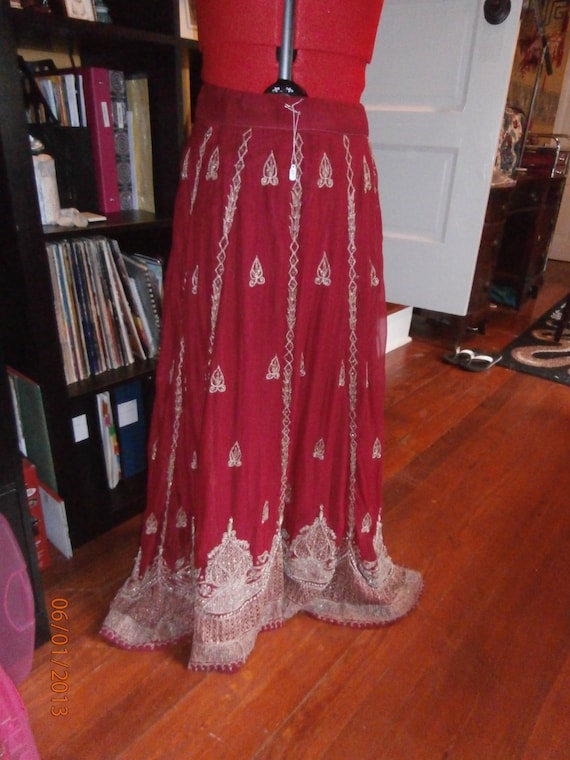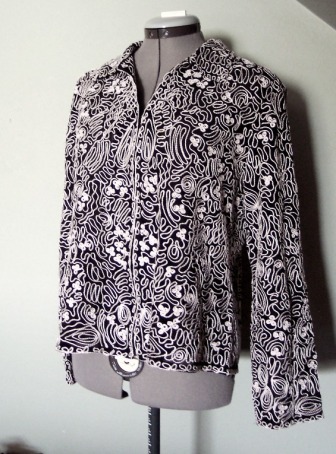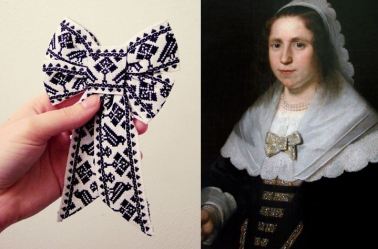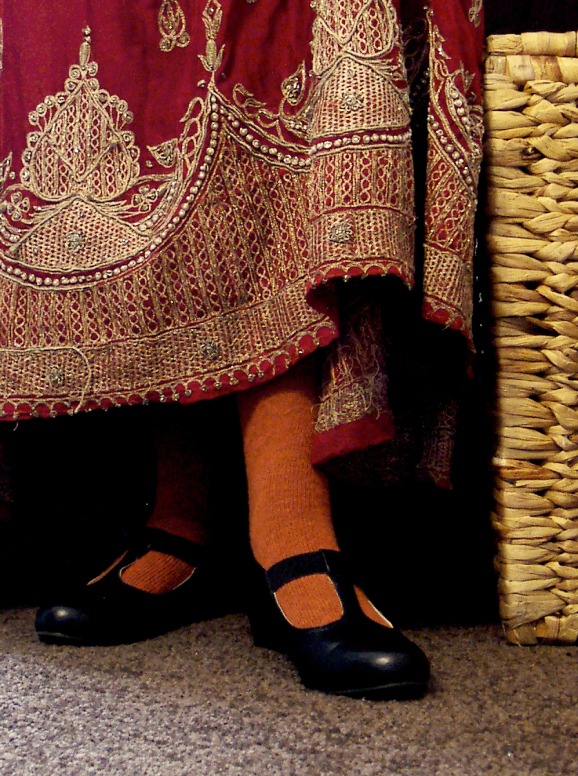Completely Hosed on Hose
Some women are obsessed with shoes. I love them, too, but my love affair with shoes is more practical than fantastical. My love of stockings, however, has grown exponentially over the years. Not only are they fun, they completely alter the way shoes fit. A shoe that is too big or even too small becomes much more comfortable with the right stocking. Keeping you warm as the weather turns chilly is a huge bonus as well.
Kittens and tea also help greatly.
When I talk about stockings, I don’t mean our modern idea of stockings– the sheer, skin tone nylons or the cutesy sock-shapes we hang up at Christmastime. Though they are both rooted in historical stockings, they are like the two seperated halves of the stocking story. Stockings in the past were knit or sewn, and while silk can be made very sheer, our ancestors valued its ability to hide skin just as much as it reveals the shape of the leg. Stockings in the historical sense are more akin to what we consider modern dress socks, and they aren’t just for ladies. Even while men were busy showing off sexy gams in tight-fitting stockings it was unseemly to show leg skin, so stockings were a necessary part of everybody’s wardrobe. Historical stockings ranged from thin silk to heavy wool, midcalf to thigh high, and plain white to wildly patterned. They’re a great way to add extra personality to any historical outfit!
The most basic of historical stockings is plain white. They were worn by men and women alike and generally reached the knee or just above it. A good pair of modern knee-high trouser socks will work nicely for almost any era from 1600-1900. I wear a pair of finely knit knee-highs I found at Dollar Tree and I love them!
Dressed for the 1960s…
..and 100 years “earlier” with my 1850s slippers!
To fit larger feet and calves, like Christopher’s, I purchased some “thigh high” knit tube socks. Since his legs are so massive, the stockings only reach his knees, but they still work.
I don’t remember his calf measurement, but his thighs are 27 inches around (same size as my waist in a corset!) and those are size 15 EEEE feet, if that’s any indication. In contrast, these stockings fit my scrawny legs at thigh level, as you can see in my garter tutorial. Our ancestors didn’t have the benefit of spandex, so they used garters to hold their stockings in place. If you use modern stockings, you don’t need to worry as much about “losing your legs,” but some tall stockings still work best with garters, plus they look so pretty!
Historical stockings also came in many solid, natural colors. My go-to historical stockings are O-Basics from Sock Dreams. They come in a variety of nice colors and are great for keeping warm in winter:
BAM! My beloved O-Basics in Rust.
Colored stockings were fairly common, especially reds and blues. The color of your stockings can be an important clue to your historical persona. For example, the Blue Stockings Society was an 18th century organization that promoted women’s education and intellectual hobbies. While Bluestockings did not necessarily wear blue stockings, the name indicated the informality and progressiveness of the club. Proper, fashionable, rich folks at the time often wore black or other expensively-colored silk stockings. Worsted wool stockings, in this case blue stockings, were considered to be informal and unfashionable. The term “bluestocking” indicated that a woman (or man) was more concerned with personal intellectual pursuits than the whims of fashion, but it was also used pejoratively around the turn of the 19th century to mean an ugly, frumpy woman (much like the word “feminist” is twisted today, sadly. It’s amazing how little things have changed in 200 years).
If you’re looking for stockings with character, there are plenty of stunning stocking options to consider! This isn’t a complete list of hosiery types by any means, just some of my favorite styles of fancy historical stockings and a few modern options that closely match.
Open Work Stockings – 19th Century
For an extra pretty pair of stockings, consider the texture as well as color. Victorian stockings are often knitted with lacy openwork designs that stretched open, revealing tiny peeks at the flesh beneath. A tad scandalous? Maybe to the ultra-conservative, but during this era of long skirts and ladies’ boots, openwork stockings offered some cool relief during warmer months.
Kitted Cotton Stocking with Double Zigzag Pattern, circa 1830
These stockings in the MFA Boston collections are very similar to this pair, dated nearly 50 years later by the Metropolitan Museum of Art:
Linen Stockings with Triple Zigzag Pattern, circa 1875-1900 (“last quarter the 19th century”)
While it’s possible that one or the other is mis-dated, the similarity is indicative of the popularity of this style throughout the era. This homemade pair of knitted socks from the middle of the century has a similar openwork style, but this time horizontally;
Cotton Stockings with Scallop Pattern, circa 1860-69
Mid-19th century stocking are often shorter than stockings found earlier and later in the century. These hit mid-calf rather than over the knee. Others hit right below the knee.
There are TONS of modern stockings that feature openwork knit patterns in every color of the rainbow! The most common colors during the mid-Victorian era were black and white. But don’t feel like you have to limit yourself. There were some pretty wild stockings out there! Colors like plum, navy, and mustard are the perfect accompaniment for a ballgown in the 1850s or a walking dress from the color-crazy 1890s . Dainty, repeating open work patterns that are more geometric and abstract rather than floral are perfect for just about any costume from 1825 to 1900!
Super Stripes! – 1850s to 1890s
The 1890s were the heyday of wild stockings! Bold colors and bolder designs were in vogue, especially the iconic striped stockings we know and love.
Cotton Stockings, circa 1890-99
Silk Stockings, circa 1880-99
The 1970s…is that you?!
The fashion wasn’t just for can-can dancers and other “ladies of the night” (who are, in fact, depicted wearing plain black stockings more often than patterned ones). Fancy stockings went well with fancy opera boots, reflecting the indulgent, candid attitude of the era– the more fancy you could squeeze onto your person, the better!
Another era that might surprise you with its hosiery is the 1850s:
Cotton Stockings, circa 1850-70
While considered a somewhat dowdy era, the 1850s saw a whole plethora of underwear trends emerge. Indeed, you almost call it the Era of Underthings! Lots of revolutionary supporting garments emerged during the era, including the pin and loop busk which allowed women to easily put on and tighten their own corsets (and marked the beginning of modern corsetry) and the iconic hoop skirt. Alongside these fashion innovations were some entertaining undergarment trends, bright red petticoats and cheerfully colored socks among them! Children’s socks were commonly patterned, showing candy stripes from under adorable little dresses throughout the Victorian era:
Tintype of Two Children, circa 1880
Source: eBay
Modern horizontally striped stocking are easy to find anywhere, especially around Halloween. Many stores like Walmart carry them, though often they are toe socks. Athletic tube socks with a banded top are also a good option, plus they come in a wide variety of colors and heights, are easy to launder, and look ridiculously cute with a Victorian bathing or cycling outfit!
Back and White Over the Knee Striped Athletic Socks from Sock Broker
Stockings with Contrasting Clocks – 1600 to 1820
One of the most iconic historical style of stocking is the clocked stocking. Clocked stockings have decorative bands and flourishes ascending from the heel or decorating the ankle. Earlier clocked stockings have a contrasting wedge shape that begins at the ankle and goes up the outside of the leg, sometimes nearly to the top of the stocking. Clocked stockings of this sort were in style for over 200 years until about 1820:
Silk, Silver Gilt, and Cotton Stockings, circa 1610
Spanish Embroidered Silk Stockings, circa 1750-70
Italian Silk Clocked Stockings, circa 1780-1825
If you are looking for a classic, upper-class 18th century or Regency stocking, American Duchess offers fine modern reproductions of classic contrast clocked stockings:
A.D. Clocked Stockings in White and Black
Victorian Floral Stockings, circa 1830-1900
From the wedge-shaped clocked design came the flourish of the Victorian years. Solid-color stockings often featured pretty woven or embroidered decoration on the front of the foot and ankle. Contrary to popular myth, ankles weren’t strictly taboo during the Victorian era, so long as they were covered with stockings. In fact, dancing and walking frequently provided glimpses of a lady’s ankles, especially when ladies wore slippers.
Cotton Stockings with Embroidered Embellishment, circa 1860
These stockings are dated to the 1860s, but are more 1870s in style.
Finding modern socks with the design localized like this at the ankle is a bit tough, but once again, American Duchess swoops to the rescue:
A.D. Edwardian Silk Stockings
Though dated as Edwardian, these stocking will work well for late 19th century, too. American Duchess also has other styles with flourishes at the ankle.

These fancy Floral Chain over the knee socks are a new from Sock Dreams! I love all the rich color choices, but this pretty beige is my fave.
If you feeling super crafty, you can make your own pair of embellished Victorian stockings! For example, the Dreamstress made a pair of silk stockings then used a bit of applique to accent her ankles:
For all the pretty without having to sew your own stockings, you could applique, embroider, or paint your chosen design onto a pair of pre-made stockings of your choice. However, if you’re feeling REALLY sassy, you can use one of the many stocking knitting patterns available online. The Antique Pattern Library, for example, has numerous Victorian instruction booklets that detail how to knit your own pair of stockings, including several editions of the Nonotuck Silk Company’s “How to Use Florence Knitting Silk” booklets from the 1880s.
Early Patterned Stockings – 17th Century
While most portraits from the 17th century show people wearing solid-colored stocking (usually in white, black, or shades of red), there are surviving examples of livelier stockings, like these:
Knitted Silk and Silver Gilt Stockings, circa 1600-1670
Child’s Silk and Gilt Stockings, 17th century
These pretties are usually child sized, but that doesn’t mean you can’t take a little inspiration from them! Combine the knitted design with the embroidered motif from these luxurious adult-sized stockings of the same era, and you get these gorgeous stockings:

S.D. Dreamer Jacquard Flowing Vine Stockings in Dijon and Navy
Can you imagine how fabulous these stockings would look with some American Duchess Stratfords or Virginias?!









































